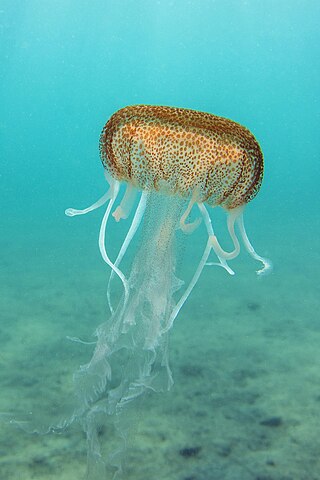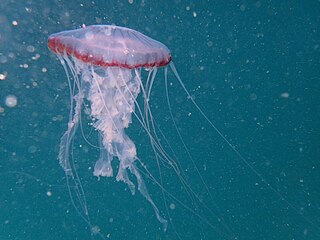
The Atlantic sea nettle, also called the East Coast sea nettle in the United States, is a species of jellyfish that inhabits the Atlantic coast of the United States. Historically it was confused with several Chrysaora species, resulting in incorrect reports of C. quinquecirrha from other parts of the Atlantic and other oceans. Most recently, C. chesapeakei of estuaries on the Atlantic coast of the United States, as well as the Gulf of Mexico, was only fully recognized as separate from C. quinquecirrha in 2017. It is smaller than the Pacific sea nettle, and has more variable coloration, but is typically pale, pinkish or yellowish, often with radiating more deeply colored stripes on the exumbrella, especially near the margin.

Pelagia noctiluca is a jellyfish in the family Pelagiidae and the only currently recognized species in the genus Pelagia. It is typically known in English as the mauve stinger, but other common names are purple-striped jelly, purple stinger, purple people eater, purple jellyfish, luminous jellyfish and night-light jellyfish. In Greek, pelagia means "(she) of the sea", from pelagos "sea, open sea"; in Latin noctiluca is the combining form of nox, "night"", and lux, "light"; thus, Pelagia noctiluca can be described as a marine organism with the ability to glow in the dark (bioluminescence). It is found worldwide in tropical and warm temperate seas, although it is suspected that records outside the North Atlantic region, which includes the Mediterranean and Gulf of Mexico, represent closely related but currently unrecognized species.

Chrysaora is a genus of jellyfish, commonly called the sea nettles, in the family Pelagiidae. The origin of the genus name Chrysaora lies in Greek mythology with Chrysaor, brother of Pegasus and son of Poseidon and Medusa. Translated, Chrysaor means "he who has a golden armament."

The black sea nettle, sometimes informally known as the black jellyfish, is a species of jellyfish that can be found in the waters of the Pacific Ocean off North America. Its range is thought to be from Monterey Bay in the north, down to southern Baja California and Mexico, though there are reports of sightings as far north as British Columbia. The initial acknowledgment of the species occurred in 1997, after large groups were found on the Pacific coast.

Chrysaora hysoscella, the compass jellyfish, is a common species of jellyfish that inhabits coastal waters in temperate regions of the northeastern Atlantic Ocean, including the North Sea and Mediterranean Sea. In the past it was also recorded in the southeastern Atlantic, including South Africa, but this was caused by confusion with close relatives; C. africana, C. fulgida and an undescribed species tentatively referred to as "C. agulhensis".

The Pacific sea nettle, or West Coast sea nettle, is a widespread planktonic scyphozoan cnidarian—or medusa, “jellyfish” or “jelly”—that lives in the northeastern Pacific Ocean, in temperate to cooler waters off of British Columbia and the West Coast of the United States, ranging south to México. The Pacific sea nettle earned its common name in-reference to its defensive, ‘nettle’-like sting; much like the stinging nettle plant, the sea nettle’s defensive sting is often irritating to humans, though rarely dangerous.

Chrysaora melanaster, commonly known as the northern sea nettle or brown jellyfish, is a species of jellyfish native to the northern Pacific Ocean and adjacent parts of the Arctic Ocean. It is sometimes referred to as a Pacific sea nettle, but this name is also used for C. fuscescens; the name Japanese sea nettle was also used for this species, but that name now exclusively refers to C. pacifica. Although jellyfish kept in public aquariums sometimes are referred to as C. melanaster, this is the result of the historical naming confusion and these actually are C. pacifica.

Jellyfish dermatitis is a cutaneous condition caused by stings from a jellyfish.

Mawia is a genus of jellyfish in the family Pelagiidae. It is a monotypic genus with the sole species Mawia benovici. The team who discovered this jellyfish named it benovici after a late colleague, Adam Benovic. Originally belonging to the genus Pelagia, it was later moved into its own genus, which was named after the Arab warrior-queen Mavia. Although described based on specimens from the Adriatic Sea, a part of the Mediterranean, it was speculated that these might be transplants rather than a part of its natural range. A later study found specimens in Senegal, indicating that its natural range possibly is the Atlantic Ocean off West Africa.
Alepas pacifica is a species of goose barnacle in the family Heteralepadidae. It is a pelagic species and is an obligate associate of various species of jellyfish. It mainly occurs in the Pacific Ocean.

Sanderia malayensis is a species of jellyfish in the family Pelagiidae, native to the tropical Indo-Pacific. It has a complex life cycle and is thought to be venomous and to have caused injuries to humans.

Chrysaora helvola is a jellyfish in the family Pelagiidae. Although still recognized as a valid species by the World Register of Marine Species, its taxonomic history is confusing and recent reviews of the genus have not recognized it.

Chrysaora chinensis, or the Indonesian sea nettle, is a species of jellyfish in the family Pelagiidae. It is native to the central Indo-Pacific region and its sting is considered dangerous.

Chrysaora lactea is a species of sea nettle in the family Pelagiidae. This jellyfish has a bell diameter of up to 25 cm (10 in), and it is native to the Atlantic coast of South America. It has also been reported from the Caribbean region, but genetic studies indicate that this population is closer to C. chesapeakei. A comprehensive taxonomic review is necessary to resolve this matter.

The South American sea nettle is a species of jellyfish from the family Pelagiidae. It is found from the Pacific coast of Peru, south along Chile's coast to Tierra del Fuego, and north along the Atlantic coast of Argentina, with a few records from Uruguay. Despite its common name, it is not the only sea nettle in South America. For example, C. lactea is another type of sea nettle in this region. Historically, C. plocamia was often confused with C. hysoscella, a species now known to be restricted to the northeast Atlantic. C. plocamia is a large jellyfish, up to 1 m in bell diameter, although most mature individuals only are 25–40 cm (10–16 in).

Chrysaora fulgida, the Benguela compass jelly, is a species of jellyfish in the family Pelagiidae. Found in the southeastern Atlantic Ocean along the western coast of South Africa, its taxonomy has historically caused considerable confusion. Like other sea nettles, its sting is painful, but not generally dangerous unless there is an allergic reaction to the venom.
Chrysaora africana, the purple compass jelly, is a species of jellyfish from the family Pelagiidae. Found in the southeastern Atlantic Ocean from Gabon to the western coast of South Africa, its taxonomy has historically caused considerable confusion. Like other sea nettles, its sting is painful, but not generally dangerous unless there is an allergic reaction to the venom.
Chrysaora pentastoma is a species of jellyfish from the family Pelagiidae. This small sea nettle has a strong sting and it is found in coastal waters of eastern South Australia.

Chrysaora chesapeakei is a sea nettle from the family Pelagiidae. It was shown to be a distinct species from Chrysaora quinquecirrha in 2017. Since then, it is also commonly known as the bay nettle. It is mainly found in the Chesapeake Bay and along the East Coast of the United States.

Jellyfish blooms are substantial growths in population of species under the phyla Cnidaria and Ctenophora.

















